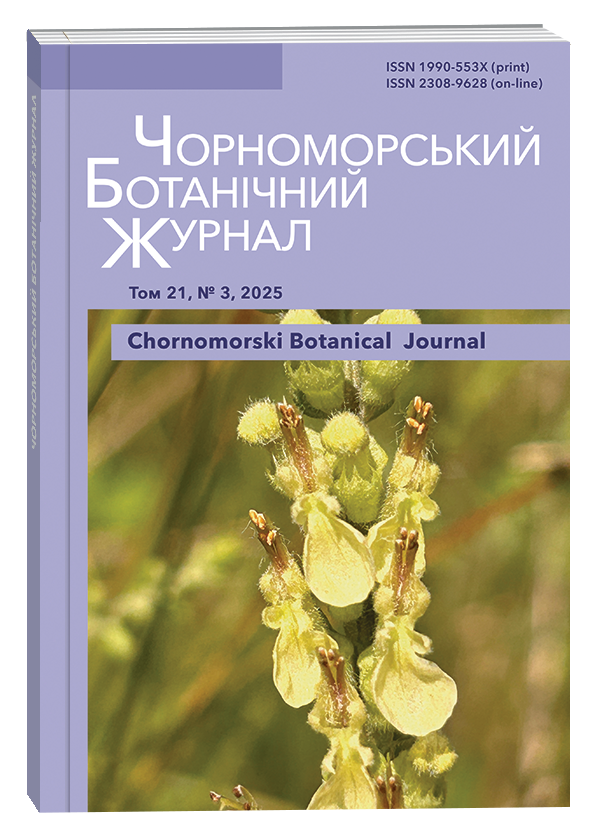Fungi of the genus Epicoccum (Pleosporales, Dothideomycetes) as a component of seed-borne infection in agricultural crops in Ukraine
DOI:
https://doi.org/10.32999/ksu1990-553X/2025-21-3-4Keywords:
biodiversity, wheat, soybean, seed contamination, diagnostics, cultures, ITS-region rDNA, polymerase chain reactionAbstract
Question: What is the species composition and occurrence of Epicoccum fungi on crop seeds in Western Ukraine? Location: Ukraine. Materials and methods: culture methods combined with genetic marker analysis. Nomenclature: https://www.indexfungorum.org/ The genus Epicoccum belongs to the group of Phoma-like fungi and is characterized by unique morphological and cultural features. Its representatives are widespread saprotrophs and facultative endophytes frequently found on the seeds of agricultural crops. Due to considerable morphological variability and the presence of twin species, accurate identification of Epicoccum isolates requires the use of molecular-genetic methods. Such studies had not been conducted in Ukraine until now. The aim of this study was to clarify the species composition of Epicoccum fungi associated with seeds of wheat, barley, and soybean grown in the western regions of Ukraine, and to analyze their frequency of occurrence. The research began in 2019 at the V.N. Karazin Kharkiv National University but was interrupted by the onset of full-scale war. The investigation was resumed in 2023–2024 in the Research Department of Continental Farmers Group company in Ternopil region. Seed samples used in the study were collected from Ivano-Frankivsk, Lviv, Ternopil, and Khmelnytskyi regions. For iden-tification of the isolates, culture-based methods and sequencing of the internal transcribed spacer (ITS) region of ribosomal DNA were employed. The results showed that the vast majority of isolates belonged to Epicoccum nigrum sensu stricto. One isolate was identified as Epicoccum tobaicum (= E. layuense), marking the first confirmed report of this species in Ukraine. Its identification was verified at the labora-tory of Professor Pedro W. Crous (Westerdijk Fungal Biodiversity Institute, the Netherlands). It was established that in 2024, the average contamination level of wheat seeds with Epicoccum spp. was 2.7 %, and 2.3 % for soybean seeds, although in some samples these values reached up to 16.8 % and 12.3 %, respectively. The presence of Epicoccum spp. in seed samples may complicate phytosanitary assessments and lead to misdiagnosis of seedborne diseases such as Fusarium infections. The results of this study may help refine seed mycological testing protocols and enhance the accuracy of seed quality assessment.
References
Abed, R.M. (2021). Exploring fungal biodiversity of genus Epicoccum and their biotechnological potential. In: Industrially Important Fungi for Sustainable Development: Volume 1: Biodiversity and Ecological Perspectives. Cham: Springer International Publishing, 237–276. https://doi.org/10.1007/978-3-030-67561-5_7
Arenal, F., Platas, G., Monte, E. & Peláez, F. (2000). ITS sequencing support for Epicoccum nigrum and Phoma epicoccina being the same biological species. Mycological Research 104 (3): 301–303. https://doi.org/10.1017/S0953756299001537
Boerema, G.H., de Gruyter, J., Noordeloos, M.E. & Hamers, M.E.C. (2004). Phoma Identification Manual: Differentiation of specific and infra-specific taxa in culture. CABI Publishing. 470 p.
Čelepirović, N., Agbaba, S. N. & Vlahović, M. K. (2024). DNA barcoding of fungi in the forest ecosystem of the Psunj and Papuk Mountains in Croatia. South-East European Forestry 20: 1–17. https://doi.org/10.15177/seefor.20-17
Chen, Q., Hou, L.W., Duan, W.J., Crous, P.W. & Cai, L. (2017). Didymellaceae revisited. Studies in Mycology 87: 105–159. https://doi.org/10.1016/j.simyco.2017.06.002
Chen, Q., Jiang, J.R., Zhang, G.Z., Cai, L. & Crous, P.W. (2015). Resolving the Phoma enigma. Studies in Mycology 82:137–217. https://doi.org/10.1016/j.simyco.2015.10.003
Hou, L.W., Groenewald, J.Z., Pfenning, L.H., Yarden, O., Crous, P.W. & Cai, L. (2020). The Phoma-like dilemma. Studies in Mycology 96: 309–396. https://doi.org/10.1016/j.simyco.2020.05.001
Jensen, B.D., Knorr, K., & Nicolaisen, M. (2016). In vitro competition between Fusarium graminearum and Epicoccum nigrum on media and wheat grains. European Journal of Plant Pathology 146 (3): 657–670. https://doi.org/10.1007/s10658-016-0950-6
Kumar, S., Stecher G., Li M., Knyaz C. & Tamura, K. (2018). MEGA X: Molecular Evolutionary Genetics Analysis across computing platforms. Molecular Biology and Evolution 35 (6): 1547–1549. https://doi.org/10.1093/molbev/msy096
Link, J.H.F. (1816). Observationes in ordines plantarum naturales. Dissert. secunda, sistens nuperas de Mucedinum et Gastromycorum ordinibus observationes. Magazin für die Neuesten Entdeckungen in der Gesammten Naturkunde, Gesellschaft Naturforschender Freunde zu Berlin 7: 25–45.
MycoBank (2024). MycoBank Database. Westerdijk Fungal Biodiversity Institute, Utrecht, Netherlands. Available at: https://www.mycobank.org [Accessed July, 18, 2025].
Ogórek, R., Przywara, K., Piecuch, A., Cal, M., Lejman, A. & Matkowski, K. (2020). Plant–fungal interactions: a case study of Epicoccoum nigrum Link. Plants 9 (12): 1691. https://doi.org/10.3390/plants9121691
Ordza, T., Węgrzyn, E., Dominiak-Świgoń, M. & Lembicz, M. (2022). Mycobiota of rye seeds infected with ergot fungi. Current Research in Environmental & Applied Mycology (Journal of Fungal Biology) 12 (1): 95–101. https://doi.org/10.5943/cream/12/1/8
Punithalingam, E., Tulloch, M. & Leach, C.M. (1972). Phoma epicoccina sp. nov. on Dactylis glomerata. Transactions of the British Mycological Society 59 (3): 341–345.
Pusz, W., Tančić-Živanov, S., Kovačević, T., Kovač, M. & Kovačević, D. (2016). Characterization of the relationships between wheat cultivars, Fusarium Head Blight, and mycoflora grains. Polish Journal of Environmental Studies 25 (3): 1137–1143. https://doi.org/10.15244/pjoes/61880
Samson, R.A., Houbraken, J., Thrane, U., Frisvad, J.C. & Andersen, B. (2019). Food and Indoor Fungi In.: Westerdijk Laboratory Manual Series No. 2. Westerdijk Fungal Biodiversity Institute, Utrecht, The Netherlands. 481 p.
Schol-Schwarz, M.B. (1959). The genus Epicoccum. Transactions of the British Mycological Society 42 (2): 149–173.
Vilgalys, R. & Hester, M. (1990). Rapid genetic identification and mapping of enzymatically amplified ribosomal DNA from several Cryptococcus species. Journal of Bacteriology 172 (8): 4238–4246. https://doi.org/10.1128/jb.172.8.4238-4246.1990
White, T.J., Bruns T., Lee S. & Taylor, J. (1990). Amplification and direct sequencing of fungal ribosomal RNA genes for phylogenetics. PCR Protocols: A Guide to Methods and Applications 18 (1): 315–322.




